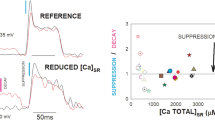Summary
Slow muscle fibers were dissected from cruralis muscles of Rana esculenta and Rana pipiens. Isometric contractures were evoked by application of K+-rich Ringer's containing Ca2+, Ni2+, Co2+, Mn2+ or Mg2+. High (7.2 mmol/liter) external Ca2+ concentration raised, 0 Ca2+ lowered the K+ threshold. Replacing Ca2+ by Ni2+ or Co2+ had an effect similar to that of high Ca2+ Ringer's. In Mg2+ Ringer's the K+ concentration-response curve was flattened. These effects were observed already after short exposure times in both species of slow fibers. When Ca2+ was removed for long periods of time the slow fibers of R. esculenta lost their contractile response to application of high K+ concentrations much more quickly than those of R. pipiens, while the response to caffeine (20 mmol/liter) was maintained. Upon readmission of Ca2+ contractile ability was quickly restored in the slow fibers of both R. esculenta and R. pipiens, but the effects of Ni2+ (or Co2+, Mn2+ and Mg2+) were much larger in R. esculenta than in R. pipiens slow fibers. It is concluded that divalent cations have two different sites of action in slow muscle fibers. K+ threshold seems to be affected through binding to sites at the membrane surface; these sites bind Ni2+ and Co2+ more firmly than Ca2+. The second site is presumably the voltage sensor in the transverse tubular membrane, which controls force production, and where Ca2+ is the most effective species of the divalent cations examined.
Similar content being viewed by others
References
Adrian, R.H., Chandler, W.K., Rakowski, R.F. 1976. Charge movement and mechanical repriming in skeletal muscle. J. Physiol. 254:361–388
Brum, G., Fitts, R., Pizarro, G., Rios, E. 1988. Voltage sensors of the frog skeletal muscle membrane require calcium to function in excitation-contraction coupling. J. Physiol. 398:475–505
Dörrscheidt-Käfer, M. 1976. The action of Ca2+, Mg2+ and H+ on the contraction threshold of muscle. Pfluegers Arch. 362:33–41
Forrester, T., Schmidt, H. 1970. An electrophysiological investigation of the slow fibre system in the frog rectus abdominis muscle. J. Physiol. 207:477–491
Frank, G.B. 1964. Evidence for an essential role for calcium in excitation-contraction coupling in skeletal muscle. Proc. R. Soc. London B. 160:504–512
Frankenhaeuser, B., Hodgkin, A.L. 1957. The action of calcium on the electrical properties of squid axons. J. Physiol. 137:217–244
Frankenhaeuser, B., Lännergren, J. 1967. The effect of calcium on the mechanical response of single twitch muscle fibres of Xenopus laevis. Acta Physiol. Scand. 69:242–254
Gilly, W.F., Hui, C.S. 1980. Voltage-dependent charge movement in frog slow muscle fibres. J. Physiol. 301:175–190
Huerta, M., Muñiz, J., Stefani, E. 1986. Effects of external calcium on potassium contractures in tonic muscle fibres of the frog (Rana pipiens). J. Physiol. 376:219–230
Krippeit-Drews, P., Schmidt, H. 1990. Divalent cations and activation of contractile force in slow muscle fibres of the frog. Pfluegers Arch. 415 (Suppl. 1):R71
Lännergren, J. 1967. The effect of calcium on potassium contractures of single slow muscle fibres of Xenopus laevis. Acta Physiol. Scand. 70:16–25
Lehmann, N., Schmidt, H. 1979. Contractile responses to direct stimulation of frog slow muscle fibres before and after denervation. Pfluegers Arch. 382:43–50
Lüttgau, H.C. 1963. The action of calcium on potassium contractures of single muscle fibres. J. Physiol. 168:679–697
Nasledov, G.A., Zachar, J., Zacharová, D. 1966. The ionic requirements for the development of contracture in isolated slow muscle fibres of the frog. Physiol. Bohemoslov. 15: 293–306
Pizarro, G., Brum, G., Fill, M., Fitts, R., Rodriguez, M., Uribe, I., Rios, E. 1988. The voltage sensor of skeletal muscle excitation-contraction coupling: A comparison with Ca2+ channels. In: The Calcium Channel: Structure, Function and Implications. M. Morad, W. Nayler, S. Kazda, M. Schramm, editors. pp. 137–156. Springer-Verlag, Berlin—Heidelberg
Pizarro, G., Fitts, R., Uribe, I., Rios, E. 1989. The voltage sensor of excitation-contraction coupling in skeletal muscle. J. Gen. Physiol. 94:405–428
Schmidt, H. 1987. Effect of divalent cations on the potassium contracture of slow muscle fibres of Rana temporaria. J. Membrane Biol. 100:215–220
Schmidt, H., Siebler, M., Krippeit-Drews, P. 1988. The effect of D600 on potassium contractures of slow muscle fibres of Rana temporaria. Pfluegers Arch. 412:390–396
Schneider, M.F., Chandler, W.K. 1973. Voltage dependent charge movement in skeletal muscle: A possible step in excitation-contraction coupling. Nature 242:244–246
Stefani, E., Steinbach, A.B. 1969. Resting potential and electrical properties of frog slow muscle fibres. Effect of different external solutions. J. Physiol. 203:383–401
Author information
Authors and Affiliations
Additional information
We are grateful to Mrs. S. Pelvay for technical assistance.
Rights and permissions
About this article
Cite this article
Krippeit-Drews, P., Schmidt, H. Effects of Ca2+ and other divalent cations on K+-evoked force production of slow muscle fibers from Rana esculenta and Rana pipiens . J. Membarin Biol. 129, 211–220 (1992). https://doi.org/10.1007/BF00219516
Received:
Revised:
Issue Date:
DOI: https://doi.org/10.1007/BF00219516




